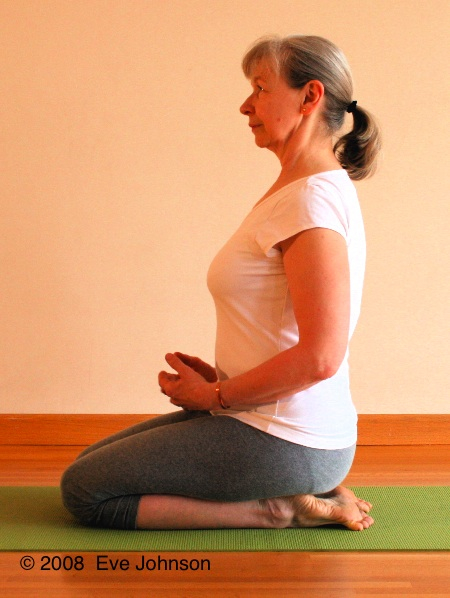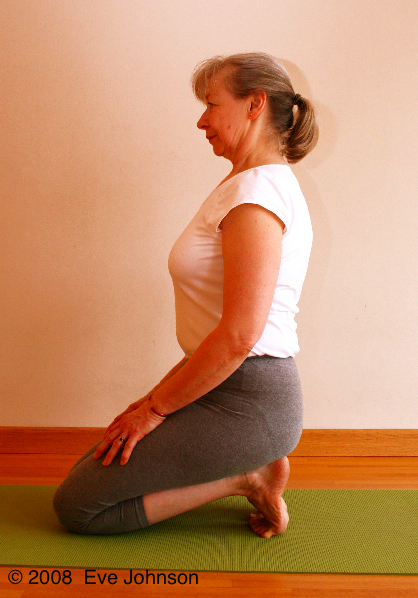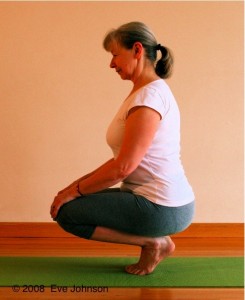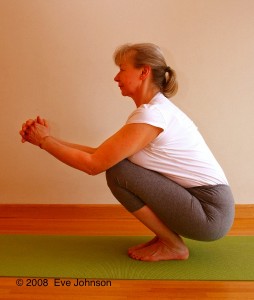
Just think, your toes used to be this easy to get to know.
When we’re babies, most of us can suck our toes. As adults, we’re much less intimate with our feet.
Yes, there’s a greater distance between brain and big toe, but we add to our disassociation with years spent walking on flat surfaces in rigid shoes.
Why worry?
Because it’s not age alone that robs us of balance and sure-footedness.
When our feet aren’t stimulated, our brains receive less information, and construct a less detailed and less reliable map of the feet. That means we can’t respond as quickly to sudden changes in surfaces, and are at a greater risk of falling.
This Five-Minute Yoga Challenge takes your feet and ankles through a wide range of positions. Make the foot-work series a regular part of your life, and after a week or two, your standing poses will be steadier, you’ll feel more grounded, better yet, you’ll know and trust your feet again.

As you sit on your heels in Vajrasana (thunderbolt pose), pull your inner ankles towards each other.
Kneel on your mat in Vajrasana (thunderbolt pose), with a chip foam block or a book of about the same thickness nearby. (First photo)
Have the sides of your big toes together, and pull your inner ankles towards each other.
Make sure that your toes face directly back, that your ankles are in line with your shins, and not bowed out.
Sit back onto your heels and bring your head directly over your spinal column.
Sit tall. Lift your chest, widen your sternum, roll your shoulder blades back and down.
If you find this position too intense, try putting a chip foam block or a folded blanket between your buttocks and your heels.
Stay for one minute or more, with long soft inhalations and long soft exhalations.

Stretch open the backs of your toes.
Now tuck your toes under and stretch the backs of your toes. (Second photo)
Take your hands to your little toes and encourage them to spread further away from your big toes.
Keep your chest lifted, and bring your body weight back, so your head is over your spinal column and your spine is over your heels.
If this feels too intense, put a chip foam block under your knees.
Stay for 30 seconds to a minute, with slow, soft breaths.

Balance on your toes.
Lift your knees and balance on your toes. (Third photo)
Again, keep your chest lifted, and stay for 30 seconds to a minute, with even breathing.
Bring your heels to the floor and sit in squat. (Fourth photo)
If your heels don’t connect well to the floor, let them rest on a chip foam block.
Stay for a minute.
Then make your way back through balancing on your toes, stretching your toes, and stretching the fronts of your ankles in Vajrasana.

Squat on your heels. If they don't reach the floor, use a chip-foam block or a book to support them.
Looking for more challenge?
Come back to balancing on your toes, and without letting your heels touch down, stand up.
Still on your toes, bring your arms up into Urdhva Hasta Tadasana (upward arms in mountain pose). Then lower your heels and your arms, and be in Tadasana (mountain pose).
Benefits: This series stretches and strengthens your feet, ankles, calves and shins and brings more awareness into your feet. Coming up to standing from being on your toes will improve your balance.
Sequence: Do the foot-work sequence on its own whenever your feet feel weary or deadened by shoes. In a longer practice, do it before standing poses, and stay aware of how much more connected you feel to the ground under your feet.
Ouch: If you haven’t worked much with your feet, this series won’t be comfortable. The pain will diminish if you persevere. Try recasting it as “sensation” – you’ll be surprised how quickly it turns to pleasure.
Work slowly and patiently, and use props to extend your time in the poses.
If you have knee injuries, check with your teacher before trying this series.
Sanskrit Corner: Say vahj-RAH-sanna. Vajra means thunderbolt. Asana means pose.
Baby photo by Charlotte Speaks, courtesy of Flickr Creative Commons.




Comments on this entry are closed.
Thank you for this series. My feet have been in intense pain from standing and walking for long periods. This series has brought relief I was not getting from anything else!
Jen,
That’s great to hear. Just remember to keep doing it after the pain goes away – for most of us that seems to be the hardest part.
I took a class last week with one of my favorite teachers and he had us do this very same sequence, repeating about three times. Unfortunately, he had us belt our ankles together which made it even more painful!! Everyone was in agony of course, but he tried to take our minds off of the pain by having us do armwork while in the foot variations. It is definitely a dreaded sequence but SO good for the health of our feet and ankles. Thanks for reminding me, I promised myself I would fit this into my home practice once a week!
Becky, thanks for passing this on.
I’ve done Vajrasana with the ankles belted together – sitting for five minutes that way – but not the whole sequence. I’ll have to try it.
The great thing about this kind of pain is that it diminishes as we do the work, unlike the pain of avoidance, which just gets bigger as time goes by.
Another unexpected and timely gift with your metaphor.
Namaste,
Trish